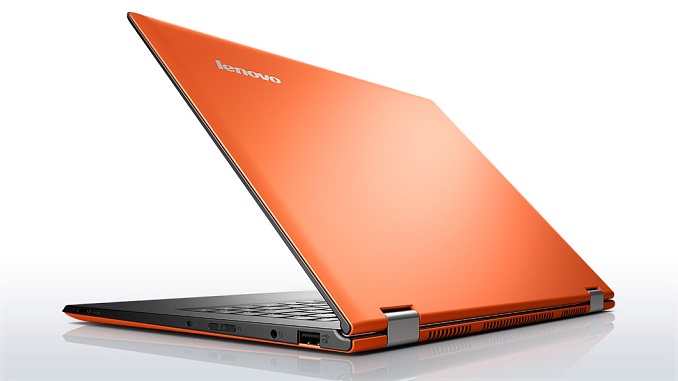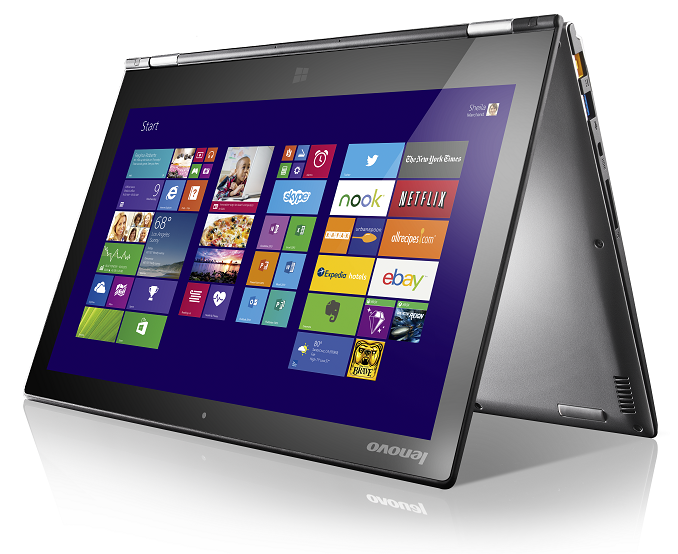Life with the Lenovo Yoga 2 Pro
by Brett Howse on July 30, 2014 2:00 PM EST- Posted in
- Notebooks
- Lenovo
- Windows 8.1
- Yoga

Introduction
In January of this year, my wife and I were in need of a new laptop. A well-documented hinge issue with our Alienware M11x R2 meant that the screen was pretty much ready to fall off. While this issue was covered by a recall, the laptop was getting long in the tooth anyway so we decided to get something newer.
The Lenovo Yoga 2 Pro seemed to be an ideal machine for our use case. With a 13.3” screen, it was only slightly larger than the Alienware’s 11.6” size which had worked well for us. At just a hair over 3 lbs, it was far lighter than the outgoing machine, and we expected a longer battery life due to the upgrade to the Haswell processor. As someone who has used Windows 8 and 8.1 extensively, I also wanted a touch screen with an IPS panel (well – anything but TN!), a decent size solid state drive, and nothing too expensive.
After doing some research on several different devices, we purchased the Yoga 2 Pro and the device I purchased in February will be the subject of this review. This was to be primarily a laptop, but one of the key points of the Yoga series is the hinge that opens a full 360° allowing the laptop to transform into a tablet. We thought this might be nice to allow some different use cases with the machine, but the primary intention for the device was to be a laptop.
The original Yoga 13 was first announced at CES in 2012 by Lenovo, and then launched in October 2012. The smaller Yoga 11 version was a Tegra 3 powered Windows RT version, but the Yoga 13 was a true Ultrabook with typical for the time Ultrabook internals – an Intel Core series processor, SSD, and 1600x900 IPS touchscreen. The original Yoga 13 was a capable Ultrabook, with its Ivy Bridge Core i5-3337U, and was later upgraded to the Yoga 2 Pro with the introduction of the fourth generation Intel Core processor.
The Yoga 2 Pro was launched as a successor to the Yoga 13 in October 2013, but it isn’t just a CPU refresh. The Yoga 2 Pro is thinner and lighter, has a backlit keyboard, and a QHD+ 3200x1800 resolution display – double the original Yoga’s resolution in both axis, to go along with the Haswell CPU refresh.
Specifications for the Yoga 2 Pro echo the usual Ultrabook template. There are options for Core i3, i5, or i7 U series processors, with Intel HD 4400 processor graphics. Storage comes via an mSATA Solid State drive in 128GB, 256GB, or 512GB of NAND versions. The screen resolution is one of the key differentiators from most Ultrabooks, with the Lenovo having 276 pixels per inch, rather than 166 DPI for 1080p at 13.3" in devices such as the Sony Vaio Pro.
| Lenovo Ideapad Yoga 2 Pro Specifications | |
| Processor |
Intel Core i3-4010U (2C/4T, 1.7GHz, 3MB L3, 15W) Intel Core i5-4200U (2C/4T, 1.6-2.6GHz, 3MB L3, 15W) Intel Core i7-4500U (2C/4T, 1.8-3.0GHz, 4MB L3, 15W) |
| Chipset | Haswell-ULT |
| Memory | 2x4GB DDR3L-1600 11-11-11 |
| Graphics |
Intel HD 4400 (20 EUs at 200-1100 MHz) |
| Display |
13.3" Glossy IPS 16:9 QHD+ (3200x1800) (Samsung SDC424A Touchscreen) |
| Storage | 128GB/256GB/512GB SSD (Samsung mSATA) |
| Optical Drive | N/A |
| Networking |
802.11n WiFi (Intel Wireless-N 7260) (2x2 300Mbps capable 2.4GHz only) Bluetooth 4.0 (Intel) |
| Audio |
Realtek HD Stereo Speakers Headset jack |
| Battery/Power |
4 cell 55Wh 65W Max AC Adapter |
| Front Side | N/A |
| Left Side |
Flash Reader (SD/MMC) 1 x USB 3.0 1 x Micro-HDMI AC Power Connection |
| Right Side |
Power Button Battery status indicator Novo button (Used to enter Recovery or BIOS) 1 x USB 2.0 (Sleep Charging) Headset Jack Volume Screen Rotation Lock |
| Back Side | Exhaust vent |
| Operating System | Windows 8.1 64-bit |
| Dimensions |
12.99" x 8.66" x 0.61" (WxDxH) (330 mm x 220 mm x 15.5 mm) |
| Weight | 3.06 lbs (1.39 kg) |
| Extras |
720p HD Webcam Backlit Keyboard |
| Colors |
Silver Grey Clementine Orange |
| Pricing |
$929 (i3, 4GB, 128GB) $1099 (i5, 4GB, 256GB) as configured $1199 (i5, 8GB, 256GB) $1299 (i7, 8GB, 256GB) $1699 (i7, 8GB, 512GB) note - not all models available in all markets |
There are some good points and poor points in this list, and we’ll go through them in detail later on. With the current state of Windows 8.1 devices that can be both tablets and laptops, there are two general distinctions. There are those where the internals are behind the display, and those with the internals in the keyboard. The distinction determines whether the device will be better as a tablet or a laptop, with the Yoga 2 Pro falling into the latter category.











103 Comments
View All Comments
bullzz - Wednesday, July 30, 2014 - link
"advertised clock speed of 1.6 GHz with all four cores at 100% usage"isnt this a dual core CPU
JarredWalton - Wednesday, July 30, 2014 - link
There are two virtual cores as well, so this was tested with a 4-threaded load.mapesdhs - Wednesday, July 30, 2014 - link
Even so, it's not correct to refer to four cores, that could easily confuse people.Personally I don't know how Intel gets away with using the i7 label for these
CPUs when they're all just dual core.
Ian.
TiGr1982 - Wednesday, July 30, 2014 - link
1. Then one should refer to four threads (as Intel names it itself officially).2. Well.. AFAIU, "i7" is just a brand, meaning "the top notch among its device class", happens to have HT, and in general has nothing to do with the particular number of physical cores:
1) i7 has 2 cores in ULV class
BUT
2) i7 has 4 cores in medium/big laptop class
3) i7 has 4 cores in mainstream desktop class
BUT
4) i7 has 6 (soon to be 8) cores in extreme desktop class
So "i7" is just a brand, supposed to make the customer think "Wow, this thing is gonna be fast".
As Semiaccurate founder calls it "iSomethingmeaningless" from the point of purely tech specs per se.
Brett Howse - Wednesday, July 30, 2014 - link
Thanks for the comment you are of course correct, it's 2 physical cores and 4 threads. Looks like Jarred already edited that sorry for the confusion.Dug - Thursday, July 31, 2014 - link
Same with i5. My desktop i5 is quad core, but my laptop is dual core.TiGr1982 - Friday, August 1, 2014 - link
Indeed; only i3 is more or less consistent (2 cores, 4 threads, no Turbo).Besides, Pentium and Celeron (based on big cores) are also consistent (when one does take into account Atoms rebranded as Celeron and Pentium).
TiGr1982 - Friday, August 1, 2014 - link
I meant, "when one does NOT take into account Atoms rebranded as Celeron and Pentium".Alexey291 - Saturday, August 2, 2014 - link
Essentially Intel CPU branding is a sordid mess - after all is said and done :)wetwareinterface - Sunday, August 3, 2014 - link
actually the pentium branding is anything but consistent right now.there are pentium cpus out right now that are based on 3rd generation dual core i3's with half the cache
dual core low voltage i3 half cache and 1-200 Mhz lower clocks than u series i3
and dual core 4th generation cores with no quick sync and hd 4000
and quad core 4th gen with quick sync enabled and hd 4000